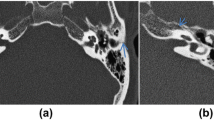Abstract
Purpose
Early facial nerve decompression is recommended for cases of post-traumatic facial palsy on the basis of ENoG with degeneration > 95%. There is still a dispute in the literature concerning the role and timing of surgery versus conservative treatment in such cases. This study has been planned to evaluate the outcome of conservative management in traumatic facial paralysis with regard to type of trauma, onset, and electrodiagnostic tests.
Methods
A prospective cohort study included 39 patients with post-traumatic facial palsy. All patients underwent ENoG, nerve stimulation test, HRCT temporal bone and Schirmer’s test. The patients received intravenous methylprednisolone 1 gm/day for 5 days or oral prednisolone 1 mg/kg in tapering doses for 3 weeks. Follow-up was done at 4, 12 and 24 weeks after the treatment. Surgical exploration was limited to patients showing no improvement after 12 weeks. Facial nerve function was evaluated by the HBFNS and FEMA grading systems.
Results
Among the 39 patients in the study [5 women and 34 men; mean (SD) age, 33.5 (11.37) years], facial nerve recovery with conservative treatment alone was noted in 31 patients. The first signs of clinical recovery were noted in 27 patients by 4 weeks, in 31 patients by 12 weeks. Seven patients required surgical exploration. At 24 weeks, 31 patients recovered to House–Brackmann grade I/III and 1 patient to grade IV. 19 of 26 patients with longitudinal fractures had grade I/III recovery, whereas all 6 patients with transverse fracture recovered on conservative treatment.
Conclusions
Patients with incomplete facial palsy are candidates for conservative management. It is justified to try conservative management in patients with complete facial paralysis for up to 3 months even in cases where ENoG and NET suggest poor prognosis. The presence of sensorineural hearing loss or transverse fracture at presentation does not suggest a poor prognosis for improvement.




Similar content being viewed by others
References
Kerr AG, Smyth GD (1987) Ear trauma. Scott-Brown’s Otolaryngology, 5th edn. Butterworths, London
Jackler RK((1990) Facial, auditory, and vestibular nerve injuries associated with basilar skull fractures. Neurol Surg 3:2305–2316
Brodie HA, Thompson TC (1997) Management of complications from 820 temporal bone fractures. Otol Neurotol 18:188–197
Fisch U (1980) Management of intratemporal facial nerve injuries. JLO 1980 94:129–134
Ulug T, Ulubil SA (2005) Management of facial paralysis in temporal bone fractures: a prospective study analyzing 11 operated fractures. Am J Otol 26:230–238
House JW, Brackmann DE (1985) Facial nerve grading system. Otolaryngol Head Neck Surg 93:146
Evans RA, Harries ML, Baguley DM, Moffat DA (1989) Reliability of the House and Brackmann grading system for facial palsy. JLO 103:1045–1046
Kim HN, Lee WS, Yoon PM, Lee HK, Kim DY(1998) Clinical application of the FEMA grading system. New horizons in facial nerve research and facial expression. Kugler, The Hague, pp 533–538
Panda NK, Kaushal D, Verma R (2012) Modified surgical approach in facial palsy: it’s worth a try. Otolaryngol Head Neck Surg 147:P214
Fisch U (1980) Maximal nerve excitability testing vs electroneuronography. Arch Otolaryngol 106:352–357
Xu P, ** A, Dai B, Li R, Li Y (2017) Surgical timing for facial paralysis after temporal bone trauma. Am J Otol 38:269–271
Darrouzet V, Duclos JY, Liguoro D, Truilhe Y, De Bonfils C, Bebear JP (2001) Management of facial paralysis resulting from temporal bone fractures: our experience in 115 cases. Otolaryngol Head Neck Surg 125:77–84
Turel KE, Sharma NK, Verghese J, Desai S (2005) Post traumatic facial paralysis. Treatment options and strategies. Indian J Neurotrauma 2:33–34
Chang CJ, Cass SP (1999) Management of facial nerve injury due to temporal bone trauma. Am J Otol 20:96–114
Fattah AY, Gurusinghe AD, Gavilan J, Hadlock TA, Marcus JR, Marres H et al (2015) Facial nerve grading instruments: systematic review of the literature and suggestion for uniformity. Plast Reconstr Surg 135:569–579
Thakar A, Gupta MP, Srivastava A, Agrawal D, Kumar A (2018) Nonsurgical treatment for posttraumatic complete facial nerve paralysis. JAMA Otolaryngol Head Neck Surg 144:315–321
Panda NK, Mehra YN, Mann SB, Mehta SK (1991) Post traumatic facial paralysis—a review. JPMA 41:105–107
Hough JV, David Stuart W (1968) Middle ear injuries in skull trauma. Laryngoscope 78:899–937
Brodsky L, Eviatar A, Daniller A (1983) Post-traumatic facial nerve paralysis: three cases of delayed temporal bone exploration with recovery. The Laryngoscope 93:1560–1565
Beck DL, Benecke JE (1993) Electroneurography: electrical evaluation of the facial nerve. J Am Acad Audiol 4:109–115
Grosheva M, Wittekindt C, Guntinas-Lichius O (2008) Prognostic value of electroneurography and electromyography in facial palsy. Laryngoscope 118:394–397
Fisch U (1974) Facial paralysis in fractures of the petrous bone. Laryngoscope 84:2141–2154
Lambert PR, Brackmann DE (1984) Facial paralysis in longitudinal temporal bone fractures: a review of 26 cases. The Laryngoscope 94:1022–1026
Coker NJ, Kendall KA, Jenkins HA, Alford BR (1987) Traumatic infratemporal facial nerve injury: management rationale for preservation of function. Otolaryngol Head Neck Surg 97:262–269
Zayas JO, Feliciano YZ, Hadley CR, Gomez AA, Vidal JA (2011) Temporal bone trauma and the role of multidetector CT in the emergency department. Radiographics 31:1741–1755
Ulug T, Ulubil SA (2005) Management of facial paralysis in temporal bone fractures: a prospective study analyzing 11 operated fractures. Am J Otolaryngol 26:230–238
Quaranta CG, Piazza F, Quaranta N, Salonna I (2001) Facial nerve paralysis in temporal bone fractures: outcomes after late decompression surgery. Actaoto-laryngologica 121:652–655
Popović D, Stanković M, Popović Z, Milisavljević D (2003) Traumatic facial palsy. Facta Univ Med Bio 1:3
Funding
This research received no specific Grant from any funding agency, commercial or not for profit sectors.
Author information
Authors and Affiliations
Corresponding author
Ethics declarations
Conflict of interest
The authors declare no conflicts of interest.
Ethical approval
All procedures performed in this study were in accordance with the ethical standards of the institutional and national research committee, and with the 1964 Helsinki declaration and its later amendments or comparable ethical standards.
Rights and permissions
About this article
Cite this article
Yadav, S., Panda, N.K., Verma, R. et al. Surgery for post-traumatic facial paralysis: are we overdoing it?. Eur Arch Otorhinolaryngol 275, 2695–2703 (2018). https://doi.org/10.1007/s00405-018-5141-y
Received:
Accepted:
Published:
Issue Date:
DOI: https://doi.org/10.1007/s00405-018-5141-y




